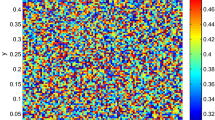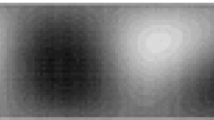Abstract
In this paper we consider a finite-volume approximation for the Cahn–Hilliard equation with dynamic boundary conditions. The convergence of the scheme is proved in Nabet (IMA J Numer Anal 36(4): 1898–1942, 2016), we prove here an error estimate for the fully-discrete scheme. We also give numerical simulations which validate the theoretical result.







Similar content being viewed by others
References
Bessemoulin-Chatard, M., Chainais-Hillairet, C., Filbet, F.: On discrete functional inequalities for some finite volume schemes. IMA J. Numer. Anal. 35(3), 1125–1149 (2015). https://doi.org/10.1093/imanum/dru032
Cherfils, L., Petcu, M., Pierre, M.: A numerical analysis of the Cahn–Hilliard equation with dynamic boundary conditions. Discrete Contin. Dyn. Syst. 27(4), 1511–1533 (2010). https://doi.org/10.3934/dcds.2010.27.1511
Choo, S.M., Chung, S.K., Kim, K.I.: Conservative nonlinear difference scheme for the Cahn–Hilliard equation—II. Comput. Math. Appl. 39(1–2), 229–243 (2000). https://doi.org/10.1016/S0898-1221(99)00326-0
Droniou, J., Nataraj, N.: Improved \(L^2\) estimate for gradient schemes and super-convergence of the TPFA finite volume scheme. IMA J. Numer. Anal. 38(3), 1254–1293 (2017). https://doi.org/10.1093/imanum/drx028
Du, Q., Nicolaides, R.A.: Numerical analysis of a continuum model of phase transition. SIAM J. Numer. Anal. 28(5), 1310–1322 (1991). https://doi.org/10.1137/0728069
Elliott, C.M.: The Cahn–Hilliard model for the kinetics of phase separation. In: Mathematical Models for Phase Change Problems (Óbidos, 1988), International Series of Numerical Mathematics, vol. 88, pp. 35–73. Birkhäuser, Basel (1989). https://doi.org/10.1007/978-3-0348-9148-6_3
Elliott, C.M., French, D.A.: Numerical studies of the Cahn–Hilliard equation for phase separation. IMA J. Appl. Math. 38(2), 97–128 (1987). https://doi.org/10.1093/imamat/38.2.97
Elliott, C.M., French, D.A.: A nonconforming finite-element method for the two-dimensional Cahn–Hilliard equation. SIAM J. Numer. Anal. 26(4), 884–903 (1989). https://doi.org/10.1137/0726049
Elliott, C.M., French, D.A., Milner, F.A.: A second order splitting method for the Cahn–Hilliard equation. Numer. Math. 54(5), 575–590 (1989). https://doi.org/10.1007/BF01396363
Elliott, C.M., Larsson, S.: Error estimates with smooth and nonsmooth data for a finite element method for the Cahn–Hilliard equation. Math. Comput. 58, 603–630 (1992). https://doi.org/10.2307/2153205
Eymard, R., Gallouët, T., Herbin, R.: Finite volume methods. In: Ciarlet, P., Lions, J. (eds.) Handbook of numerical analysis, vol. VII, Handbook of numerical analysis, VII, pp 715–1022. North-Holland, Amsterdam (2000)
Eyre, D.J.: Unconditionally gradient stable time marching the Cahn–Hilliard equation. In: Symposia BB—Computational and Mathematical Models of Microstructural Evolution, MRS Proceedings, vol. 529 (1998). https://doi.org/10.1557/PROC-529-39
Feng, X., Prohl, A.: Error analysis of a mixed finite element method for the Cahn–Hilliard equation. Numer. Math. 99(1), 47–84 (2004). https://doi.org/10.1007/s00211-004-0546-5
Feng, X., Prohl, A.: Numerical analysis of the Cahn–Hilliard equation and approximation of the Hele–Shaw problem. Interfaces Free Bound. 7(1), 1–28 (2005). https://doi.org/10.4171/IFB/111
Fischer, H., Maass, P., Dieterich, W.: Novel surface modes in spinodal decomposition. Phys. Rev. Lett. 79(5), 893–896 (1997). https://doi.org/10.1103/PhysRevLett.79.893
Fischer, H., Maass, P., Dieterich, W.: Diverging time and length scales of spinodal decomposition modes in thin films. EPL (Europhysics Letters) 42(1), 49–54 (1998). https://doi.org/10.1209/epl/i1998-00550-y
Furihata, D.: A stable and conservative finite difference scheme for the Cahn–Hilliard equation. Numer. Math. 87(4), 675–699 (2001). https://doi.org/10.1007/PL00005429
Jacqmin, D.: Contact-line dynamics of a diffuse fluid interface. J. Fluid Mech. 402, 57–88 (2000). https://doi.org/10.1017/S0022112099006874
Kay, D., Styles, V., Welford, R.: Finite element approximation of a Cahn–Hilliard-Navier–Stokes system. Interfaces Free Bound. 10(1), 15–43 (2008). https://doi.org/10.4171/IFB/178
Kenzler, R., Eurich, F., Maass, P., Rinn, B., Schropp, J., Bohl, E., Dieterich, W.: Phase separation in confined geometries: solving the Cahn–Hilliard equation with generic boundary conditions. J. Comput. Phys. Commun. 133(2–3), 139–157 (2001). https://doi.org/10.1016/S0010-4655(00)00159-4
Kovács, B., Lubich, C.: Numerical analysis of parabolic problems with dynamic boundary conditions. IMA J. Numer. Anal. 37(1), 1–39 (2016). https://doi.org/10.1093/imanum/drw015
Nabet, F.: Convergence of a finite-volume scheme for the Cahn–Hilliard equation with dynamic boundary conditions. IMA J. Numer. Anal. 36(4), 1898–1942 (2016). https://doi.org/10.1093/imanum/drv057
Shen, J., Yang, X.: Numerical approximations of Allen–Cahn and Cahn–Hilliard equations. Discrete Contin. Dyn. Syst. 28(4), 1669–1691 (2010). https://doi.org/10.3934/dcds.2010.28.1669
Author information
Authors and Affiliations
Corresponding author
Additional information
Publisher's Note
Springer Nature remains neutral with regard to jurisdictional claims in published maps and institutional affiliations.
Proof of proposition 7
Proof of proposition 7
For \(f \in L^2(\varOmega )\) and \(g \in L^2(\varGamma )\), we consider the following problem: find \(u:\varOmega \rightarrow {\mathbb {R}}\) such that \(\int _\varOmega u = \alpha \) and
By integrating equation (59a) on all interior control volumes \({\scriptstyle {\mathcal {K}}}\in {\mathfrak {M}}\) and the boundary condition (59b) on all boundary control volumes \({\scriptstyle {\mathcal {L}}}\in \partial {\mathfrak {M}}\), the two-point flux approximation of problem (59) writes as follows. Find \(u_{{\scriptscriptstyle {\mathcal {T}}}}\in {\mathbb {R}}^{{\scriptscriptstyle {\mathcal {T}}}}\) such that \(\sum \limits _{{\scriptscriptstyle {\mathcal {K}}}\in {\mathfrak {M}}}m_{{{\scriptscriptstyle {\underline{{\mathcal {K}}}}}}}u_{{\scriptscriptstyle {\mathcal {K}}}}=\alpha \) and
We can prove that this problem admits a unique solution.
Because of the complex geometry of \(\varOmega \), it is possible to take into account some points \(x\in \varOmega ^c\) in the proof of the error estimate. To ensure that all the quantities used in the proof of Theorem 2 are well defined, we will use an extension in \(\varvec{{\mathbb {R}}}^2\) of the function u. Since \(u \in H^2(\varOmega )\), there exists an extension \({{\widetilde{u}}} \in H^2(\varvec{{\mathbb {R}}}^2)\) (that we fix in the sequel) such that
with \(C_{{}26}>0\) depending only on \(\varOmega \).
Proposition 16
The tangential gradient of \(u:\varGamma \rightarrow {\mathbb {R}}\) to the vertex \({\mathbf{v }}={\scriptstyle {\mathcal {L}}}|{\scriptstyle {\mathcal {L}}}'\) satisfies
where \(\varphi \) is an arc-length parametrization of the curve \(\varGamma \) and \({\vec {\varvec{\tau }}}_{\varvec{{\scriptscriptstyle \mathbf{v }},{\scriptscriptstyle {\mathcal {L}}}}}({\mathbf{v }})\) is the unit tangent vector to \(\varGamma \) at point \({\mathbf{v }}={\scriptstyle {\mathcal {L}}}|{\scriptstyle {\mathcal {L}}}'\) going from \({\scriptstyle {\mathcal {L}}}\) to \({\scriptstyle {\mathcal {L}}}'\).
Proof
Let us consider the points \(t_{{\scriptscriptstyle {\mathcal {L}}}},t_{{\scriptscriptstyle \mathcal {L}'}},t_{{\scriptscriptstyle \mathbf{v }}}\in {\mathbb {R}}\) such that \(x_{{\scriptscriptstyle {\mathcal {L}}}}=\varphi (t_{{\scriptscriptstyle {\mathcal {L}}}})\), \(x_{{\scriptscriptstyle \mathcal {L}'}}=\varphi (t_{{\scriptscriptstyle \mathcal {L}'}})\) and \({\mathbf{v }}=\varphi (t_{{\scriptscriptstyle \mathbf{v }}})\), then the Taylor’s formulas give
Noting that \(|t_{{\scriptscriptstyle \mathcal {L}'}}-t_{{\scriptscriptstyle {\mathcal {L}}}}|=m_{\gamma _{{\scriptscriptstyle {\mathcal {L}}}{\scriptscriptstyle \mathcal {L}'}}}\) we conclude the proof. \(\square \)
Thanks to the Taylor’s formulas we can prove the following proposition.
Proposition 17
Let \({\scriptstyle {\mathcal {L}}}\in \partial {\mathfrak {M}}\) be a boundary control volume and \({\mathbf{v }}\) be a vertex of \({\scriptstyle {\mathcal {L}}}\), then the following equality holds
Moreover for any point \(x\in \sigma ={\scriptstyle {\mathcal {L}}}\in {\mathcal {E}}_{ext}\), one has
where \({\varvec{\vec {\mathbf {n}}}}_{\varvec{\sigma {\scriptscriptstyle {\mathcal {K}}}}}(x)\) is the unit normal vector to \(\sigma \) outward to \({\scriptstyle {\mathcal {K}}}\) at point x.
We are now in position to prove the main result of the appendix.
Theorem 2
Let us assume that the solution u of the continuous problem (59) belongs to \(H^2_{\scriptscriptstyle \varGamma }(\varOmega )\). Let us consider the solution \(u_{{\scriptscriptstyle {\mathcal {T}}}}\) to discrete problem (60). Then, there exists \(C_{{}27}>0\) independent of \(\text { size}({\mathcal {T}}\,\,)\) such that
with \( e_{{\scriptscriptstyle {\mathcal {T}}}}={{\mathbb {P}}}^{{c}}_{{{\scriptscriptstyle {\mathcal {T}}}}}u - u_{{\scriptscriptstyle {\mathcal {T}}}}\).
We decompose the proof of Theorem 2 into two steps. As a first step, we prove (see Proposition 18) that the left-hand side of inequality (62) is bounded from above by the different consistency errors which intervene in the problem. In a second phase, we have to estimate these different consistency errors.
Proposition 18
Let us consider the solution u to problem (59) and the solution \(u_{{\scriptscriptstyle {\mathcal {T}}}}\) to discrete problem (60). Then the following estimate holds
where,
Proof
Let \({\scriptstyle {\mathcal {K}}}\in {\mathfrak {M}}\), we integrate equation (59a) on \({\scriptstyle {\mathcal {K}}}\) and we subtract the resulting equality with equation (60a). Thanks to definitions of \(R^{int}_{{\scriptscriptstyle \sigma },{\scriptscriptstyle {\mathcal {K}}}}\) and \(R^{ext}_{{\scriptscriptstyle \sigma },{\scriptscriptstyle {\mathcal {K}}}}\) given in Proposition 18 imply
In the same way let \({\scriptstyle {\mathcal {L}}}\in \partial {\mathfrak {M}}\), we integrate equation (59b) on \({\scriptstyle {\mathcal {L}}}\) and we subtract the resulting equality with equation (60b). Then we obtain
Now we multiply equation (64) by \(e_{{\scriptscriptstyle {\mathcal {K}}}}\) and summing up over \({\scriptstyle {\mathcal {K}}}\in {\mathfrak {M}}\) and we multiply equation (65) by \(e_{{\scriptscriptstyle {\mathcal {L}}}}\) and summing up over \({\scriptstyle {\mathcal {L}}}\in \partial {\mathfrak {M}}\). Then, summing the resulting equalities we have
Owing to the Cauchy–Schwarz and the Young inequalities, we obtain estimate (63). \(\square \)
With this proposition at hand we are now able to prove Theorem 2 by estimating all the terms of the right-hand side of (63).
Proof
First, let \(\sigma ={\scriptstyle {\mathcal {K}}}|{\scriptstyle {\mathcal {L}}}\in {\mathcal {E}}_{int}\) thanks to the Taylor’s formulas we have
Owing to the Jensen inequality and the change of variables \((t,x)\in [0,1]\times \sigma \mapsto y =x+t(x_{{\scriptscriptstyle {\mathcal {K}}}}-x)\) (or \((t,x)\in [0,1]\times \sigma \mapsto y =x+t(x_{{\scriptscriptstyle {\mathcal {L}}}}-x)\) for the second term) and since for any \({\scriptstyle {\mathcal {K}}}\in {\mathfrak {M}}\), \(\text {diam}({\scriptstyle {\mathcal {K}}})\le \text {reg}({\mathcal {T}}\,\,)d(x_{{\scriptscriptstyle {\mathcal {K}}}},\sigma )\), for any \(\sigma \in {\mathcal {E}}_{\scriptscriptstyle {\mathcal {K}}}\) (see Definition 5) one has
Noting that \(m_{{\scriptscriptstyle {\mathcal {D}}}}=\frac{m_{{\scriptscriptstyle \sigma }}d_{{\scriptscriptstyle {\mathcal {K}}},{\scriptscriptstyle {\mathcal {L}}}}}{2}\) we obtain
Secondly let \(\sigma ={\scriptstyle {\mathcal {L}}}\in \partial {\mathfrak {M}}\), thanks to definition (61) of \({{\widetilde{u}}}\) we have \(u(x_{{\scriptscriptstyle {\mathcal {L}}}})={{\widetilde{u}}}(x_{{\scriptscriptstyle {\mathcal {L}}}})\) and \(u(x_{{\scriptscriptstyle {\mathcal {K}}}})={{\widetilde{u}}}(x_{{\scriptscriptstyle {\mathcal {K}}}})\), thus since \(x_{{\scriptscriptstyle {\mathcal {L}}}}-x_{{\scriptscriptstyle {\mathcal {K}}}}=d(x_{{\scriptscriptstyle {\mathcal {K}}}},x_{{\scriptscriptstyle {\mathcal {L}}}})\vec {\varvec{\mathbf {n}}}_{\varvec{{\scriptscriptstyle {\mathcal {K}}}{\scriptscriptstyle {\mathcal {L}}}}}\), the definition of \(R^{ext}_{{\scriptscriptstyle \sigma },{\scriptscriptstyle {\mathcal {K}}}}\), the Jensen inequality and the Taylor’s formulas imply
Thanks to Propositions 2, 3 and 17 , there exists \({C_{{\scriptscriptstyle \varGamma }}}>0\) independent of \(\text { size}({\mathcal {T}}\,\,)\) such that
Thus, thanks to a change of variables in the last two integrals we have
where \({\scriptstyle {\mathcal {D}}}_{{\scriptscriptstyle {\mathcal {L}}}}=\{ (1-t)x+tx_{{\scriptscriptstyle {\mathcal {L}}}}: t\in [0,1], x\in \sigma ={\scriptstyle {\mathcal {L}}}\}\). Then, owing to (61) we obtain
Finally, using definition of \({R_{{\mathbf{v }},{\scriptscriptstyle {\mathcal {L}}}}}\) for any \({\mathbf{v }}={\scriptstyle {\mathcal {L}}}|{\scriptstyle {\mathcal {L}}}'\in {\mathcal {V}}\) we have
Thanks to Proposition 16 and 17 , we obtain
Gathering estimates (66), (67) and (68) the claim follows. \(\square \)
We have obtained an error estimate between the center-value projection of the exact solution \({{\mathbb {P}}}^{{c}}_{{{\scriptscriptstyle {\mathcal {T}}}}}u\) and the approximate solution \(u_{{\scriptscriptstyle {\mathcal {T}}}}\) for the Laplace problem with Ventcell boundary conditions for the \(H^1\)-seminorms. However in order to prove Proposition 7 we also need to prove an estimate between the exact solution u and the approximate solution \(u_{{\scriptscriptstyle {\mathcal {T}}}}\) for the \(L^2\)-norms. To conclude we adopt here the same reasoning as that given in [11, Theorem 10.1] for the Laplace problem with Neumann boundary conditions, apart from the fact that here the domain is not polygonal.
Let \(\beta _{{\scriptscriptstyle {\mathcal {T}}}}\in {\mathbb {R}}\) such that \(\sum \limits _{{\scriptscriptstyle {\mathcal {K}}}\in {\mathfrak {M}}}m_{{{\scriptscriptstyle {\underline{{\mathcal {K}}}}}}}{{\bar{u}}}(x_{{\scriptscriptstyle {\mathcal {K}}}}) = \alpha \) with \({{\bar{u}}}=u+\beta _{{\scriptscriptstyle {\mathcal {T}}}}\). Setting \({\bar{e}}_{{\scriptscriptstyle {\mathcal {K}}}}= {{\bar{u}}}(x_{{\scriptscriptstyle {\mathcal {K}}}}) - u_{{\scriptscriptstyle {\mathcal {K}}}}\) for any \({\scriptstyle {\mathcal {K}}}\in {\mathfrak {M}}\) and \({\bar{e}}_{{\scriptscriptstyle {\mathcal {L}}}}= {{\bar{u}}}(x_{{\scriptscriptstyle {\mathcal {L}}}}) - u_{{\scriptscriptstyle {\mathcal {L}}}}\) for any \({\scriptstyle {\mathcal {L}}}\in \partial {\mathfrak {M}}\), estimate (62) is also satisfied for \({\bar{e}}_{{\scriptscriptstyle {\mathcal {T}}}}\). However, thanks to its definition the error \({\bar{e}}_{{\scriptscriptstyle {\mathfrak {M}}}}\) has now zero mean-value on \({\underline{\varOmega }}\). Thus if \(\text { size}({\mathcal {T}}\,\,)\le \frac{1}{2 {C_{5}}}\), the discrete Poincaré inequality (7) gives
and thanks to the trace inequality (Lemma 4) we have
Thanks to the regularity of the function u, denoting by \(L_u\) the Lipschitz constant of u, one has
We recall that \(\int _\varOmega u = \sum \limits _{{\scriptscriptstyle {\mathcal {K}}}\in {\mathfrak {M}}}m_{{{\scriptscriptstyle {\underline{{\mathcal {K}}}}}}}{{\bar{u}}}(x_{{\scriptscriptstyle {\mathcal {K}}}}) = \alpha \) and \(\beta _{{\scriptscriptstyle {\mathcal {T}}}}= {{\bar{u}}}- u\), thus one has
and
Thus thanks to the regularity of u, Proposition 1 and the mesh regularity (5) we can claim that \(| \beta _{{\scriptscriptstyle {\mathcal {T}}}}| \le C \text { size}({\mathcal {T}}\,\,)\) that concludes the proof.
The reasoning is exactly the same for the \(L^2(\varGamma )\)-norm that concludes the claim.
Rights and permissions
About this article
Cite this article
Nabet, F. An error estimate for a finite-volume scheme for the Cahn–Hilliard equation with dynamic boundary conditions. Numer. Math. 149, 185–226 (2021). https://doi.org/10.1007/s00211-021-01230-7
Received:
Revised:
Accepted:
Published:
Issue Date:
DOI: https://doi.org/10.1007/s00211-021-01230-7




